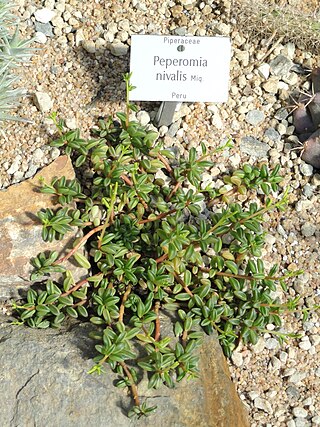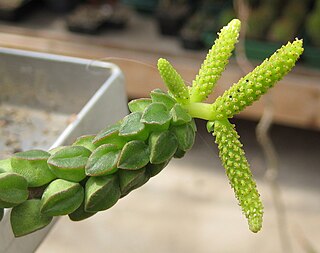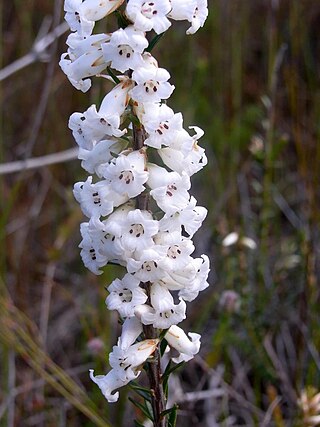
Peperomia is one of the two large genera of the family Piperaceae. It is estimated that there are at least over 1,000 species, occurring in all tropical and subtropical regions of the world. They are concentrated in northern South America and Central America, but are also found in Africa, southern Asia, and Oceania. The exact number is difficult to tell as some plants have been recorded several times with different names and new species continue to be discovered. Peperomias have adapted to many different environments and their appearance varies greatly. Some are epiphytes or lithophytes, and many are xerophytes (drought-tolerant) either with thick succulent structures or with underground tubers (geophytes). Most species are compact perennial shrubs or vines.

The Piperaceae, also known as the pepper family, are a large family of flowering plants. The group contains roughly 3,600 currently accepted species in 5 genera. The vast majority of species can be found within the two main genera: Piper and Peperomia.

Senna obtusifolia, known by the common names Chinese senna, American sicklepod, sicklepod, etc., is a plant in the genus Senna, sometimes separated in the monotypic genus Diallobus. It grows wild in North, Central, and South America, Asia, Africa, and Oceania, and is considered a particularly serious weed in many places. It has a long-standing history of confusion with Senna tora and that taxon in many sources actually refers to the present species.

Senna tora is a plant species in the family Fabaceae and the subfamily Caesalpinioideae. Its name is derived from its Sinhala name tora (තෝර). It grows wild in most of the tropics and is considered a weed in many places. Its native range is in Central America. Its most common English name is sickle senna or sickle wild sensitive-plant. Other common names include sickle pod, tora, coffee pod and foetid cassia. It is often confused with Chinese senna or sickle pod, Senna obtusifolia.

Peperomia graveolens is a species of plant in the genus Peperomia of the family Piperaceae. It is endemic to Ecuador.

Peperomia nivalis is a species of plant in the genus Peperomia endemic to Peru. Its native habitat is found in the high altitude ranges of the peruvian Andes. P. nivalis is a compact erect succulent herb with fleshy stems and leaves. The thick leaves are cuneate and U-shaped in cross-section with epidermal windows on the top-side. The leaf color is bright green in the shady summer and reddish during dry sunny seasons.

Peperomia pellucida is an annual, shallow-rooted herb, usually growing to a height of about 15 to 45 cm, it is characterized by succulent stems, shiny, heart-shaped, fleshy leaves and tiny, dot-like seeds attached to several fruiting spikes. It has a mustard-like odor when crushed.

Peperomia columella is a species of plant in the family Piperaceae. The species is endemic to Peru. It grows in dry areas, often in crevices on steep cliffs or in sandy soil. It grows to about 20 cm in height, forming snake-like stems, which carry closely packed succulent bright green leaves. The leaves are truncated, U-shape in cross-section, with epidermal windows on top. It can be kept as a houseplant and has received the Award of Garden Merit by the Royal Horticultural Society.

Ziziphus obtusifolia is a species of flowering plant in the buckthorn family known by several common names, including lotebush, graythorn, gumdrop tree, and Texas buckthorn.

Peperomia tetraphylla, known as the acorn peperomia or four-leaved peperomia, is a small plant in the Peperomia genus and the Piperaceae family that grows natively in tropical and subtropical regions around the world. Additionally in can found on Easter Island as an introduced species.

Epacris obtusifolia, commonly known as blunt-leaf heath, is a species of flowering plant from the heath family, Ericaceae, and is endemic to eastern Australia. It is an erect shrub with few stems, crowded, oblong to elliptic leaves and tube-shaped white or cream-coloured flowers arranged along the stems.

Peperomia obtusifolia, also known as the baby rubberplant, American rubber plant, or pepper face, is a species of flowering plant in the genus Peperomia under the family Piperaceae, native to Florida, Mexico and the Caribbean. The specific epithet obtusifolia means "blunt-leaved". The plant has gained the Royal Horticultural Society's Award of Garden Merit.

Quercus magnoliifolia, also known as encino amarillo, encino avellano, encino bermejo, encino blanco, encino napis, encino prieto, and roble, is a Mexican species of oak. It is widespread along the Pacific Coast of Mexico from Sinaloa to Chiapas, and also found inland as far as Zacatecas and Puebla.

Peperomia rotundifolia, also known as jade necklace, trailing jade, creeping buttons and round leaf Peperomia, is a trailing plant species of peperomia native to the tropical rainforest of South America. The first European to describe it was Carl von Linné, and got its current name from Carl Sigismund Kunth.

Peperomia maculosa, commonly known as spotted-stalked peperomia and spotted peperomia, is a species of plant in the genus Peperomia. Its native range is from Mexico to northern South America.

Peperomia nitida is a species of plant in the genus Peperomia. Its native range is in South America from Brazil to northern Argentina. It can be kept as a houseplant and is sometimes sold as cupid peperomia, or problematically as Peperomia scandens or Peperomia serpens.
Peperomia macrorhiza is a species of plant in the genus Peperomia. It is endemic to Peru. It is a geophytic plant, storing water and reserves in an underground tuber. During dry periods parts above ground, such as leaves, will wither away but the plant will survive due to the tuber. When more rain falls the plant regrows its stalks and leaves on the surface.

Peperomia quadrangularis, commonly known as the beetle peperomia, is a species of plant in the genus Peperomia of the family Piperaceae. Its native range is in tropical America, including areas in northern South America, Central America and the West Indies.

Peperomia boivinii is a species of plant in the genus Peperomia of the family Piperaceae. It is endemic to the Comoro Islands situated between the southeastern coast of Africa and Madagascar. It is sometimes called the jade peperomia.

Peperomia polybotrya, commonly known as raindrop peperomia or raindrop plant, is a species of perennial plant in the genus Peperomia of the family Piperaceae. It is native to Colombia, Ecuador, and Peru.



















